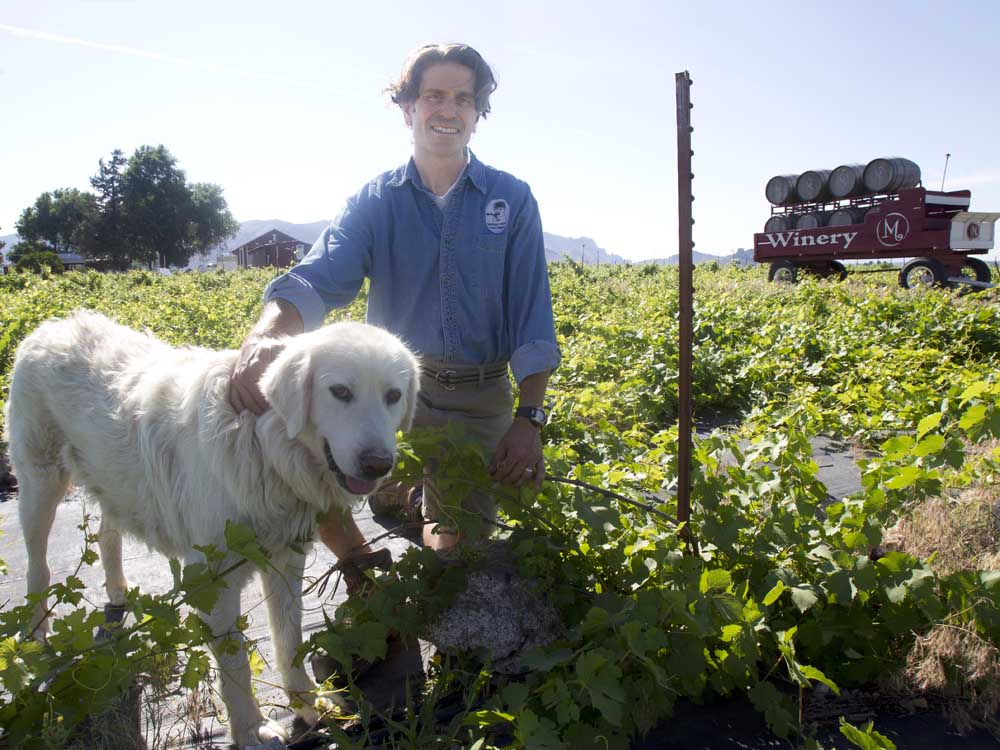Temps ideal for grape crop
Published 12:00 am Friday, July 10, 2015

- Andy Tullis / The BulletinDoug Maragas and his Maremma, Snow, pause while looking over the variety of grapes growing at Maragas Winery in Culver.
Local vintners think this summer’s spate of 90-degree temperatures is doing some fantastic things for the upcoming grape harvest.
“It’s going to be a stellar year,” said Doug Maragas, owner of Maragas Winery, which is about 30 miles north of Bend off U.S. Highway 97 between Terrebonne and Madras. “Everybody’s going to have big harvests.”
Wine grape varieties like Cabernet Sauvignon, Merlot and Zinfandel, which Maragas uses in his Merlot-Cabernet blend, “M,” and his Zinfandel, “Legal Zin,” produce most of their glucose, fructose and other natural sugars when they ripen on their vines during the summer months.
Maragas said wine grapes reach the peak of the sugar production when temperatures climb above the 80-degree mark. The fruit will go dormant and shut down this process if it gets too hot outside — usually temperatures of 100 degrees or higher — so it can conserve energy and survive another day.
And so far, Maragas said Central Oregon’s summer has given him everything he needs for a good grape harvest.
That’s because the daytime high temperatures recorded at the Redmond Airport have soared past the 80-degree mark for all but two of the 29 days between June 6 and July 4 this year, according to the National Weather Service’s climate reports.
They’ve only climbed into the 100-degree danger zone for three of those 29 days.
“This heat has been good for the vines,” said Cindy Grossman, part-owner of Faith, Hope and Charity Vineyards.
Grossman said her grapes “are growing like crazy” on her land due east of Terrebonne. She has had to cool them off with overhead irrigation on afternoons that threatened to climb above the 100-degree mark.
But the hot temperatures are only part of the story, Maragas said.
That’s because it’s possible for the grapes to produce too much sugar when they’re ripening on the vine. He said wine runs the risk of having too much heat, a flavor that comes from its alcohol content, or having too sweet of a taste if there is too much sugar in the fruit when it’s harvested.
The key to avoiding this problem is to grow grapes in a region with a hefty swing between the day’s high and low temperatures. Colder nighttime temperatures give the natural acids and other flavor compounds found inside the grapes a chance to develop after the “fruit’s photosynthesis machinery” takes a break when the sun goes down.
“Cooler evenings are a big thing,” Maragas said. “We wouldn’t get any complexity (in our wines) if you didn’t have them.”
And here too, Central Oregon’s wine makers have not been disappointed.
The average daytime-high temperature recorded at the Redmond Airport between June 6 and July 4 was 89.1 degrees while the average low was 48.7 degrees, according to the National Weather Service.
This 40-degree swing between high and low temperatures nearly guarantees Central Oregon’s grapes will have a chance to operate as sugar producing machines during the day and as flavor refining machines at night.
The only downside of this year’s promising grape crop is no immediate gratification.
The “M” takes 5½ years to mature, the “Legal Zin” takes three to four before it’s put in a bottle and ready to drink, Maragas said.
Grossman’s Marquette grapes — a hybrid variety that she’s growing on her landfor the first time this year — won’t be picked until late September, early October. It will be another two years before these grapes are turned into wine, bottled and put on the shelves.
If vintners are right about this growing season, however, the wine will be worth the wait.
— Reporter: 541-617-7816, mmclean@bendbulletin.com






